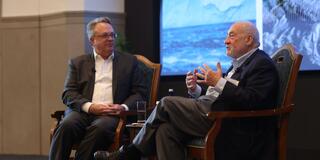Joseph Stiglitz Discusses How to Price Climate Change

Financial markets may be imperfect, according to University Professor and Nobel Laureate Joseph Stiglitz. But at some point, he said, markets “are likely to wake up and say, ‘Golly, there is such a thing as climate change,’ and change the value of assets in a dramatic way — which will have global financial consequences.”
That’s one of the key takeaways from a keynote address Stiglitz gave at the Second Annual Environmental Economics and Policy Conference on October 2, hosted by the Federal Reserve Bank of New York in partnership with Columbia SIPA.
Besides the keynote speech, the all-day event featured a series of academic paper presentations and panel discussions on how to quantify and mitigate climate risk, targeted to an audience of academics, economists, urbanists, financial services professionals, community leaders, and policy advocates. SIPA-affiliated participants included Professors Douglas Almond and Wolfram Schlenker and PhD candidate Anna Papp, who presented a paper she coauthored with fellow PhD candidate Florian Grosset and 2022 PhD graduate Charles Taylor.
Stiglitz’s keynote lecture provided some critical insights at the intersection of economics and climate change. Among other things, he said that early models aimed at calculating the costs of climate change and risk to developing economies were way off. Stiglitz also reflected on the 1995 Report of the Intergovernmental Panel on Climate Change (IPCC) and how it used the term "global warming" rather than the more comprehensive "climate change."
Innovation doesn’t just happen, it’s the result of purposeful activity…. The thing we really ought to be working on is saving the planet.
— Joseph Stiglitz
“The term ‘global warming’ doesn’t really capture what is going on,” Stiglitz said. “What we realized, especially in the last two years, is that climate change includes not just a change in average degrees, the way we summarized it, but variability: droughts, floods, hurricanes, extreme weather events which make large parts of the world uninhabitable…. What we’re talking about here is a much more profound effect on our society.”
Stiglitz suggested that early climate models lacked a deep understanding of the impacts of climate change, like the expansion of regions like the Sahel region in Africa and potential displacement around the world due to rising sea levels. Another significant point of contention lay in the optimal temperature for climate action, with American economists advocating 2.8 degrees of warming, while the scientific community emphasized the risks associated with anything beyond 2 degrees.
Stiglitz also talked about risk, which he said many integrated assessment models failed to adequately incorporate. He criticized both the Ramsey model and dynamic stochastic general equilibrium (DSGE) for their inability to capture the complexities of real-world economies in the context of climate change.
The Ramsey model, originally designed for economic analysis, has been adapted to incorporate environmental and climate change considerations. However, using the Ramsey model for real-world economic analysis has proven problematic, with disastrous consequences on macroeconomic dynamics.
This is also true for DSGEs , which are essentially modifications of the Ramsey model. These models rely on certain assumptions such as agents with infinite lives and stationary conditions, which are not suitable for modeling the dynamic and complex nature of the climate and the changing economic landscape. Additionally, technical issues, like inaccuracies in functional analysis and the omission of important market failures beyond environmental issues, further limit the usefulness of these models. Overall, the outdated assumptions and limitations of these models make them inadequate for understanding and addressing the complexities of today's world economy and climate challenges.
President John C. Williams of the New York Fed then joined Stiglitz for additional conversation. The two men discussed the challenges of insurance markets, the impact of market failures on individuals' access to insurance, and the implementation of a carbon tax as a potential solution. Stiglitz highlighted the presence of information asymmetry and institutional failures, which prevented necessary markets from emerging.
To address the market failure in the context of climate change, Stiglitz said that implementing a carbon tax is a viable solution. You have the option of focusing on either the price or the quantity of emissions. When you focus on quantity, there is a risk of overregulation, while with prices, there's a risk of underregulation. An example of uncertainty in action can be seen in the tax credit within the Inflation Reduction Act, for which estimates of the cost range from $150 million to closer to $1 billion or even $1.5 billion in some cases. In an ideal world, constantly updated nonlinear price tables would be preferred, but in reality, the best we can achieve is discrete measurements of quantity and price at specific points in time.
Stiglitz called for further research into the effectiveness of green finance and increased financial support for climate-related initiatives, like favorable Treasury loans to stimulate green investments.
“Innovation doesn’t just happen,” Stiglitz observed. “It’s the result of purposeful activity. Right now, a lot of our innovation is making a better advertising engine in Silicon Valley so you buy things you wouldn’t otherwise buy. From a societal point of view that’s not the optimal way of allocating scarce resources…. The thing we really ought to be working on is saving the planet. That means more energy efficiency, carbon reductions in agriculture, new transportation systems, how to build better buidlings. And all of that is incentivized by having clear standards of where you’re going.
“We’ve had enormous success in reducing the cost of renewable energy,” he added. “And it’s really been transformative.”